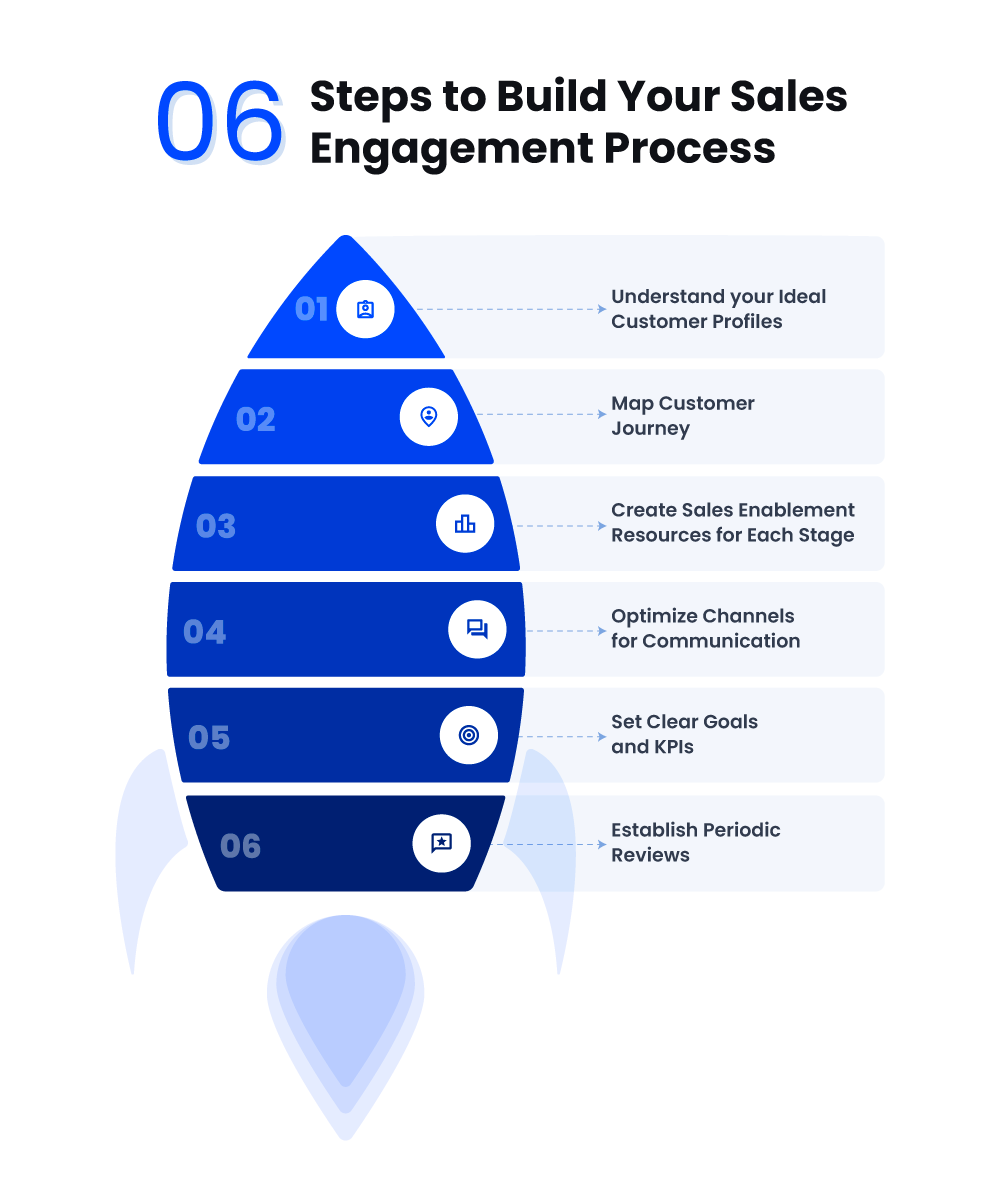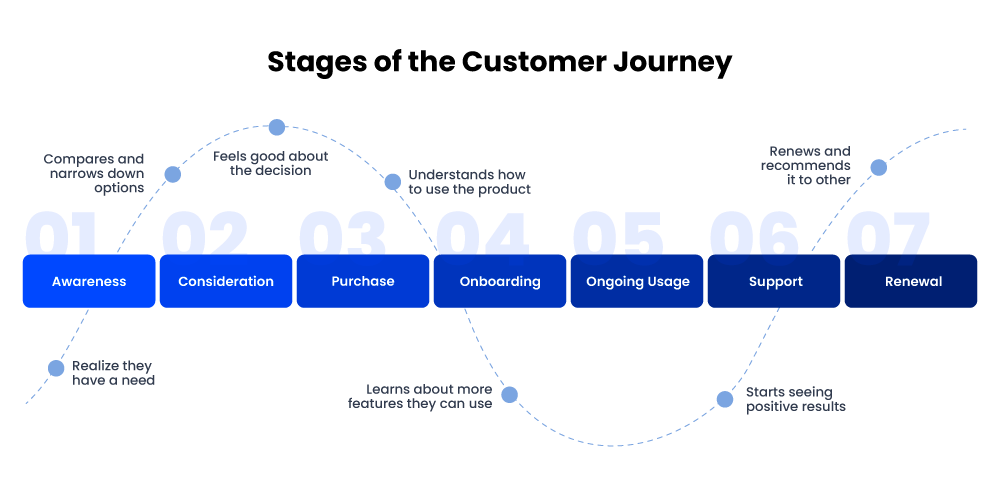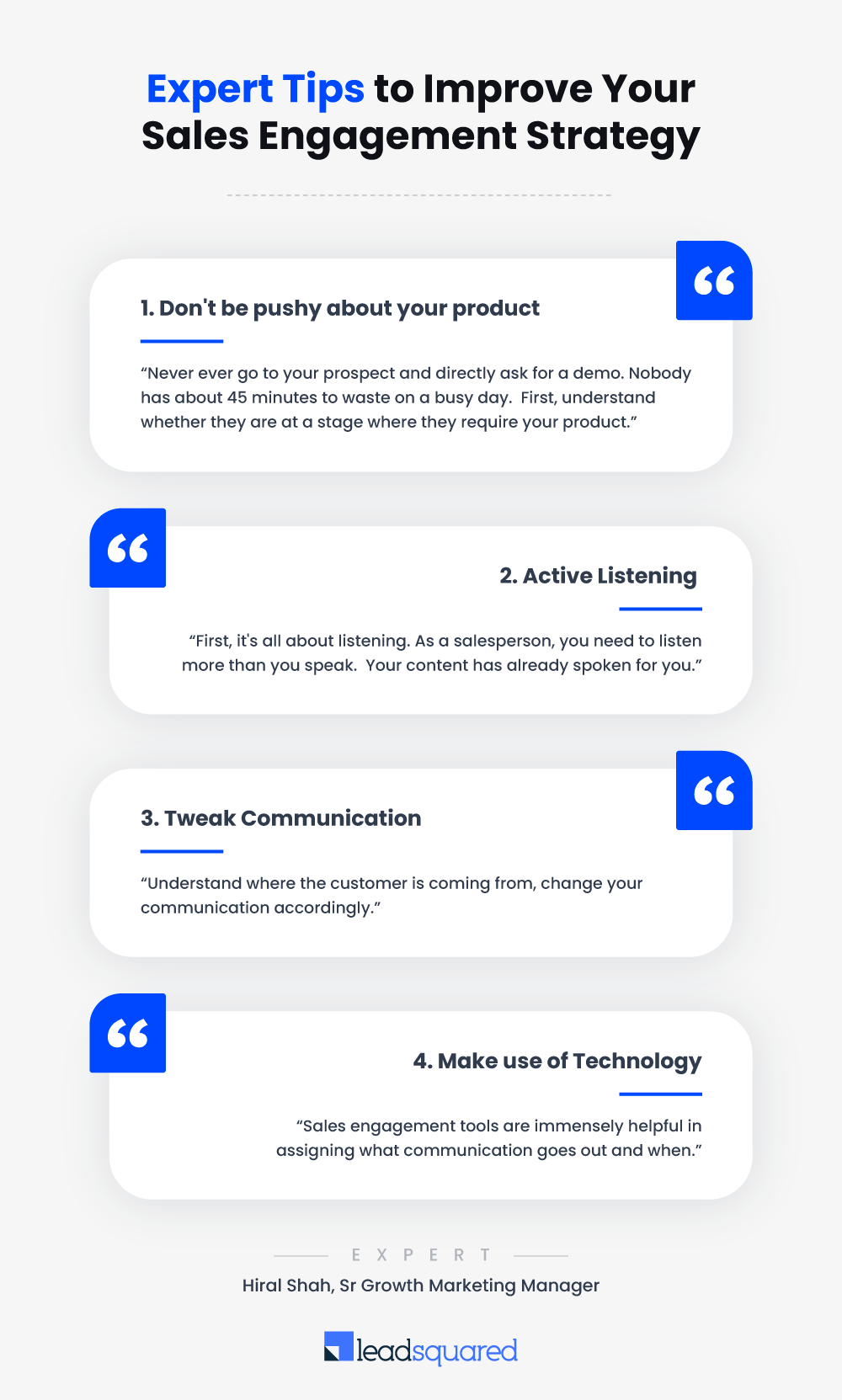“Sales is an outcome, not a goal. It’s a function of doing numerous things right, starting from the moment you target a potential prospect until you finalize the deal.”
– Jill Konrath
What happens when a customer gets multiple calls from various sales reps from the same company? At first, they’ll say no but after being bombarded with calls, texts, and emails, they’ll eventually block the sales reps.
Experiences like these are frustrating for your prospects; and they come across as a lousy form of sales engagement. Even if your prospect was initially interested in your product, they might end up choosing your competitor. Why?
- The business disregarded their preferences.
- The salespeople were aggressive and pushy with their pitch.
- They were inconsistent with their communication.
- The engagement focused solely on making a sale.
To avoid this, it’s essential to build a solid sales engagement strategy. Through this article, you’ll learn what sales engagement is all about and how you can leverage technology to create a strategy tailored to your organization.
What is Sales Engagement?
Sales Engagement is a process where you establish and nurture meaningful relationships with the prospects during a sales cycle. It entails creating a consistent and personalized omnichannel strategy with your customer’s preferences in mind.
There are multiple ways to engage with prospective buyers. Here are a few examples of sales engagement workflows:
- Reaching to prospects via phone calls to introduce products or services.
- Sending personalized emails to generate interest and encourage further communication
- Engaging on various social media platforms to build relationships, share content and respond to queries.
- Setting up online or face-to-face sales meetings to conduct product demonstrations.
- Attending industry conferences, trade shows, and networking events to meet prospects and establish connections.
- Offering conversational engagement with real time chat support on websites to guide the prospects.
- Hosting lunch and learn sessions where prospects can learn about the product or industry while networking.
Now, that is a LOT of things to keep track of. Plus, having a wide variety of customers with different backgrounds and preferences, makes it difficult to cement a strategy that works for everyone.
But, according to a study by Harvard Business Review, 92% of executives agree that effective customer engagement is critical to their organization’s success. Now, let’s understand why that’s the case.
Why is it Important to have a Sales Engagement Process?
Having a process in place makes things easier. It not only helps you enhance your revenue but also simplifies internal tracking.
1. Optimized Onboarding
A detailed and structured sales engagement process is an asset during sales onboarding. It gives your sales reps a step-by-step approach to engaging with prospects. With a documented strategy, it is also easier to track, improve, and measure the performance of new team members.
2. Consistent Brand Messaging
According to research by McKinsey, more than half of the consumers use three to five channels while purchasing. Omnichannel marketing is no longer optional, it’s a necessity. With a proper sales engagement strategy in place, you can control the messaging for consistent communication across various channels. It also ensures that you don’t overwhelm your prospects by being pushy or overbearing.
3. Shorter Sales Cycle
A sales engagement strategy results in faster communication and responsiveness through a variety of channels. Having a structured follow-up strategy with timely nurturing keeps the prospects engaged and shortens the sales cycle.
4. Higher Conversions
Improving the quality of interactions by providing relevant, valuable content to the prospects results in higher conversion and revenue growth. According to a study, organizations that invested in customer engagement reported a 70% increase in their revenue.
5. Improved Customer Relationships
Fostering personalized and relevant interactions greatly enhances customer relationships. When you actively listen to your prospects and offer tailored solutions to address their pain points, it shows that you genuinely care. It not only helps you close deals faster but also leads to stronger customer relationships and long-term business success.
A sales engagement process can truly turn around your business. You must be eager to know how to create your own. But before we move on to that, let’s clear up a common confusion.
People often mix up sales engagement and sales enablement since they are very intertwined. Although they have distinct goals people often club them together because they both word towards boosting sales effectiveness.
Sales Engagement vs. Sales Enablement
Think of sales enablement as providing a chef with a well-equipped kitchen, quality ingredients, and a cookbook. It sets the stage for success.
Now, sales engagement is like the chef using those tools and ingredients to create a delightful dish.
It involves the chef’s active participation, creativity, and communication to serve a satisfying meal to the customers. Now let’s understand how exactly they are different in more detail.
Name | SALES ENGAGEMENT | SALES ENABLEMENT |
Definition | The activities that salespeople undertake to connect with prospects, nurture relationships, and close deals. | Providing resources, processes, and support to sales teams to help them sell more effectively. |
Goal | Aims to facilitate meaningful relationships, understand customer needs, and guide prospects towards conversion. | Strives to create and provide the sales team with the right resources and support to improve efficiency. |
Components | Email campaigns, phone calls, virtual or face-to-face meetings, consistent follow-ups. | Marketing collaterals, Content management, sales enablement tools, training programs. |
Key Benefits |
|
|
Metrics to Measure Success | Conversion rates, customer satisfaction, social media engagement | Sales team productivity, content utilization, competitive win rate |
Now let’s move on to understanding how you can build your sales engagement strategy.
6 Steps to Build Your Sales Engagement Process

1. Understand your Ideal Customer Profiles
Before you start engaging with prospects, it is essential to identify whom to engage with. Targeting the wrong prospects with no potential for conversion is going to waste your time. To understand who the right prospects are, you can build your customer profile.
An ideal customer profile (ICP) is based on different parameters like demographics, buying patterns, preferences, etc. Defining your ICP helps you create targeted engagement strategies to yield the highest conversions.
2. Map Customer Journey

Each of your target prospects is at a different stage of the customer journey. Customer journey mapping gives you a visual representation of all the steps and touchpoints you have with them.
With complete visibility into interactions, you can optimize each touchpoint effectively. Analysing why and how your prospect behaves in each stage is crucial to forecast and personalize the next steps in the process.
3. Create Sales Enablement Resources for Each Stage
For every different stage of the customer journey, you need different content. You can set up workflows to define what kind of content your sales reps should share with their prospects.
For example, during the awareness stage, blog posts, infographics, and videos will be more effective rather than case studies and product demos.
Tailoring content to each stage will improve your customer’s experience and foster trust and credibility.
4. Optimize Channels for Communication
Your prospects are active on channels like email, phone, and social media platforms. As we discussed earlier, focusing on just one channel does not help. It is important to identify and optimize the channels that your customers prefer for communication.
You can set up automated triggers for omnichannel engagement. For example, if your prospects sign up for a webinar, you can share the joining link via email and WhatsApp/SMs. This makes it more convenient for them and opens more opportunities to engage with the prospect.
5. Set Clear Goals and KPIs
You have a roadmap of whom to engage with, what tool to use, and at which stage.
Now what?
You have to ensure that the steps that you take are working. You can set up goals and measure them with key performance indicators (KPIs). Some of the sales engagement KPIs that you can measure based on your goals are as follows:
1. Net Promoter Score (NPS)
4. Engagement Rate
5. Average Session Duration
6. Deal Win Rate
7. Customer Acquisition Cost (CAC)
6. Establish Periodic Sales Reviews
It is crucial to conduct regular reviews to ensure that your engagement strategy is up to date with the changing market dynamics. You can set up these to be undertaken on a quarterly or annual basis.
Here are a few things you can conduct your reviews on:
1. Along with performance metrics, you can gather feedback from customers and prospects.
2. Talk to your sales team about what is working and the challenges they face.
3. Analyze your content and ensure it is aligned with your customer needs and market trends. Also, ensure your brand’s messaging comes across as you intend it to.
4. Evaluate your competitor’s strategy and identify where you can differentiate.
5. Re-evaluate your target customer segments. Are they still lucrative opportunities, or should you focus on others?
Based on these, adjust your goals, refine your strategies, and make updates if needed!
Be open to experimentation to understand what works best for you.
Now that you have a process in place, let’s look at how you can make it even better. I spoke to LeadSquared’s in-house sales expert, Hiral Shah, for insights into optimizing sales engagement.
Expert Tips to Improve Your Sales Engagement Strategy

1. Don’t Be Pushy About your Product
The way you approach each prospect will be different. You can’t just ask the prospective buyer who landed on your website for a demo call.
During the awareness stage, listen to them and understand what they are looking for. If your prospect came across your blog, ask them how it helped them and if there are any additional resources you can share.
Sometimes, when prospects are past the awareness stage, they still may not know their problem statement. But once you understand it, make them aware of their problem.
In this stage, you can share case studies to showcase how other businesses in the industry dealt with similar situations.
“Never ever go to your prospect and directly ask for a demo. Nobody has about 45 minutes to waste on a busy day. First, you need to understand whether they are at a stage where they require your product.”
– Hiral Shah, Sr Growth Marketing Manager
2. Active Listening
“First, it’s all about listening. As a salesperson, you need to listen more than you speak. Your content has already spoken for you.”
– Hiral Shah, Sr Growth Marketing Manager
Everyone wants to sell their product and pitch it. However, it is essential to practice active listening. Try to understand the issues your prospects are facing, their use case, and what they do. Ultimately, it makes it easier for you to pitch your product or service.
3. Demonstrate Value
That brings us to our next point, which is how you can be valuable to the buyers. You need to understand their problems, map them to your product, and tailor your solution to their problem statement.
You need to identify the core of their problem. Ask yourself questions like “What can you fix in their workflow?” and “What are the integrations you can offer to provide an all-around solution?”
Every buyer organization wants to know what their return on investment (ROI) will be. Tap into creating that perfect pitch for when the buyer is in the decision stage.
4. Tweak Communication
One of the common mistakes that sales reps make is talking about the same thing to different decision-makers. But each one of them has a separate problem statement. When you are talking to a CEO, talk about the overall product, what will be the return on investment (ROI), and what positive impact it will bring to their organization.
In the same vein, when you are speaking to a marketing person, they would want to know how you can make their processes more streamlined. Essentially, how can your product make their day-to-day work easier?
“Understand where the customer is coming from, change your communication accordingly.”
– Hiral Shah, Sr Growth Marketing Manager
5. Make use of Technology
A sales engagement tool helps you coordinate better and ensure your communications and follow-ups are consistent. Sales engagement platforms have features like contact management and automated workflows to ensure your multichannel communication does not overwhelm your prospects. With its reporting features, it also enables you to measure your KPIs and update your strategies.
“Sales engagement tools are immensely helpful in assigning what communication goes out and when.”
– Hiral Shah, Sr Growth Marketing Manager
Now that you know how you can level up your sales engagement strategy, let’s understand the ways in which the right tool can help you achieve success.
Powering Up with Sales Engagement Platforms
A Sales engagement platform (SEP) is a software that can make your sales processes simpler and more optimized. LeadSquared is one of the leading sales engagement platforms with its comprehensive sales and marketing tools that top companies enrich their engagement strategy. Employing such a tool can help you with the following:
1. Contact Management
- Prospecting: A sales engagement platform provides you with data to find buyers to target. Sales prospecting is necessary to avoid spending time on leads who are not interested. LeadSqaured also provides features like lead and engagement scoring that make qualifying leads easier than ever.
- Segmentation: It can also help you segment your audience based on different criteria like region, lead score, their activity, or what stage of the buyer’s journey. This way, you can easily share relevant content at the right time.
- Targeting: You can also set up triggers to keep your prospects engaged. Send automated emails and WhatsApp messages if they sign up for a demo. If they download an e-book, automate sharing additional resources that they might find helpful.
2. Workflow Automation
- Lead Assignment: Ensures multiple salespersons aren’t reaching out to the same lead. Auto-assign prospects to sales reps based on various rules. Automatic lead distribution saves time and enables you to work on leads as they come in instantly.
- Content Sharing: You can publish email templates and phone scripts for your sales reps. You can make this editable so they can be tweaked according to the prospects.
- Follow-ups: Timely follow-ups are crucial to close a deal. Using a SEP, you can set up reminders and triggers when the salesperson needs to call them or send a communication.
- Update Lead Stages: Automate lead stage updation once an activity is added. It swiftly sets up the next course of action items for your sales reps. Reducing manual tasks also enables your sales reps to spend more time on selling rather than on admin activities.
3. Multichannel Engagement

- Emails: Set up multiple email campaigns to nurture your prospects. You can measure click-through rates (CTRs) and open rates to analyze if your campaigns are working. Conduct A/B testing to experiment with your content and subject lines to optimize them.
- Calls: Integrate with telephony to record calls for later analysis. Get call reports and add notes about what was discussed in the call for future reference.
- Social Media: You can also integrate your social media channels like LinkedIn, Instagram, Twitter, etc. You can gather insights about engagement and audience demographics to reach your prospects more proactively.
- WhatsApp/ SMS messaging: Manage all your conversations on one platform. Keep track of conversation history and use pre-approved WhatsApp message templates to engage with buyers. Using tools like Converse by LeadSquared offer you prior context and activity history to communicate with prospective buyers.
- Chatbots: Website chatbots can be integrated with your sales engagement platform (SEP). Automate frequently asked questions and navigation on your website. And then handover the conversation to sales reps to take it forward.
4. Analytics and Reporting
When you have so much data, of course, you ought to measure if it’s working. A sales engagement platform includes robust reporting tools to build custom reports to measure all your metrics.
It also gives you a visual view of your engagement strategy. You can look into your performance on your platforms, your messaging, how sales reps perform, and so much more.
Using a sales engagement platform (SEP) makes your operations smooth. It helps you put things in motion toward perfecting your sales engagement strategy.
Final Thoughts
In conclusion, effective sales engagement is not just a function but a process of building valuable relationships with your prospects. It’s about being consistent, relevant, and using omnichannel communication to guide them on their journey.
Remember, sales engagement is not about bombarding potential customers with relentless calls, texts, and emails. Instead, it’s about understanding their needs, preferences, and pain points. It’s all about personalizing your approach and fostering trust.
Sales engagement platforms like LeadSquared can streamline your operations, improve the sales process, and help you connect more effectively with your prospects.
Book a call with our sales experts to learn more about how your organization can transform your sales engagement process and boost success in the world of sales.
FAQs
1. What are the benefits of using a sales engagement platform?
A sales engagement platform can enhance the effectiveness, productivity, and consistency of a sales team, leading to increased sales and improved customer relationships. Its benefits include:
1. Personalization at Scale
2. Omnichannel Outreach
3. Less Manual Tasks
4. Data-driven Decisions
5. Scaling Sales Operations
2. Who should use sales engagement platforms and why?
A sales engagement platform is a valuable tool for a variety of teams within a sales organization.
1. Sales reps use the platform to streamline their daily tasks, automate follow-ups etc.
2. Sales managers use the platform to monitor and coach their teams, track performance, and measure goals.
3. Marketing teams use the platform to align their efforts with sales, by providing sales teams with relevant content and enabling coordinated multichannel outreach.
3. What are the levels of engagement in sales?
In sales, engagement levels can vary but they generally include the following:
1. Prospecting
2. Initiating contact
3. Analyzing their needs
4. Nurturing the relationship
5. Proposing your offer
6. Negotiating the deal
7. Closing the sale









